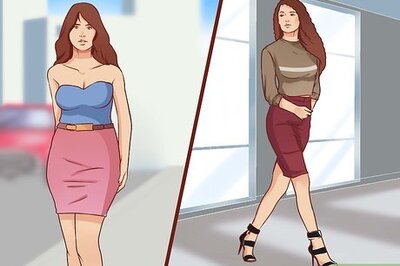
views
Getting Rid of Yellow Jackets in the Ground
Try soap and hot water if the nest is small. This home remedy sometimes works for tiny nests, but it might not be your best option for a large infestation. However, if you’d like to try it, boil a bucket of water and then mix in a few drops of dish soap. Then, pour the mixture into the entry and exit holes to the nest. The soap will bog down the yellow jackets and make it hard for them to fly, while the hot water will (hopefully) kill them. If you have a large nest that you’re dealing with, you’re probably better off with diatomaceous earth or an insecticide.
Try diatomaceous earth for an eco-friendly product. If you’re not a fan of harsh chemicals but you’d still like to kill the yellow jackets, pick up a bag of diatomaceous earth. This product is made from the fossilized remains of aquatic organisms called diatoms, and it kills insects by penetrating their outer shell and drying them out. In small quantities, diatomaceous earth isn’t toxic to humans or wildlife, so it’s safe to use around your family and your pets. The only time it can get dangerous is if you inhale it or get it on your skin during the application process. Be sure to wear an N95 mask for protection as well as gloves and safety goggles.
Use insecticidal dust to kill yellow jackets faster. Need to get rid of yellow jackets in just a few days? No problem! Head to the hardware store and pick up an insecticidal dust product made specifically for wasps. The dust will attack the nervous system of any wasp it encounters, eventually killing the whole hive in about 48 hours. Insecticidal dust isn’t toxic to humans, but it can cause mild discomfort if inhaled. Be sure to wear a mask and gloves during the application process to keep yourself safe. Although some hardware stores sell liquid or aerosol yellow jacket insecticide, experts warn that these aren’t as effective as dust applications. With liquids and aerosols, you can never be sure you’ve reached the entire nest, so you might only kill part of the hive.
Wait until nightfall when the yellow jackets are less active. If you apply your product during the daytime, there’s a very high likelihood of getting stung. Instead, wait until the sun sets when the yellow jackets have gone back inside to sleep. That way, they should all be inside of the nest instead of flying around guarding it. During the day time, there will usually be 1 or 2 yellow jackets at each exit and entry point acting as guards.
Sprinkle or pour the product into the entry and exit holes of the nest. Take a look around and try to spot all of the holes that lead to the nest (usually there’s at least 2). Grab your product and dump a liberal amount into each hole, aiming to cover it completely. When you’re done, walk away quickly, just in case you made any yellow jackets inside angry. To make this process quicker, try scooping the product into a paper cup and then dumping it into the nesting holes. When you’re done, just throw the paper cup in the trash.
Wait 2 to 10 days for full yellow jacket control. Depending on which product you use, you should notice a decrease in yellow jacket activity over the next week or so. Diatomaceous earth tends to take a little longer, while insecticidal dust will act much faster. Try to stay out of the nesting area, just in case the yellow jackets are agitated.
Seal the holes up after 2 months. This will help prevent new yellow jackets from coming in and taking over the hive. You can cover the nesting holes with bricks, rocks, or even a tarp as you wait for yellow jacket season to end. If you seal the holes up while the yellow jackets are still alive, they’ll just create a new exit point, and you’ll be dealing with the same issue all over again.
Locating a Yellow Jacket Nest
Look for holes in the ground that are brownish-gray. If you’ve ever seen a wasp’s nest hanging in a tree or on a house, then you know exactly what to look for. The actual nest part of the yellow jacket’s nest will be hidden underground, but their entry and exit holes will be visible on the surface of your lawn. Look for small holes that are brown or gray, and kind of look like they’re made of paper. Yellow jacket nests are most commonly found in your garden or near flower beds.
Follow the yellow jackets that are flying around your yard. Eventually, they’ll lead you back to their nest. Do this carefully, though—yellow jackets can get aggressive quickly, especially when they feel threatened. If you see a couple of yellow jackets flying around your yard, try to spot where they enter or exit the ground. Then, head over to the area at night when they’re less active to check it out and find the nest. If you’re allergic to yellow jacket stings, stay far away from them, and don’t risk getting stung just to find their nest.
Watch for yellow jackets as you mow the lawn. Unfortunately, some people stumble upon yellow jacket nests when they’re doing yard work. If you’re blissfully mowing the lawn and all of the sudden get swarmed by a group of yellow jackets, you’ve found their nest. Get as far away from it as you can while the yellow jackets are active, then head back out at night to see where exactly the nest is. When you encounter yellow jackets, walk away quickly and in a straight line. Even though it’s hard, try not to swat at them or crush them, since that will only make them more aggressive. Yellow jackets can (and will) fly faster than humans can run, so get inside as quickly as you can instead of trying to outrun them.
Make sure you’re dealing with yellow jackets, not bees. Wasps and yellow jackets look similar to bumble bees that also nest in the ground. To double check that what you’re seeing is actually wasps, get as close to one as you can and look for their characteristic bright yellow bodies with black lines. Yellow jackets have hard, shiny bodies, whereas bumble bees have rounder bodies with lots of little hairs. Once you’re sure that you’ve found a yellow jacket’s nest, you can start planning your attack. Bumble bees are important pollinators, and they’re also considered endangered. If you have a bumble bee nest in the ground, consider using non-lethal ways to get rid of it so you don’t kill a hive of essential pollinators.

















Comments
0 comment